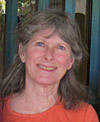Statement/Bio
Born in 1950 in Torrington, Connecticut, I grew up in Massachusetts and went to college at the nearby Rhode Island School of Design. There, I learned the silkscreen printing process from Art Wood, while abandoning an illustration major in favor of the art education program. After graduating with a BFA in 1972, I taught art in elementary school for three years, while my husband Bob finished law school. Then we moved to the D.C. area, where he started making a name for himself in public interest law and I began printing full-time, exhibiting work in galleries and museums.
Like many other screen printers, though, I found it increasingly sickening to breathe the fumes of oil-based inks, so in 1987, I switched to non-toxic, water-based inks and stencil materials.
As our two kids got older, I began teaching at the Art League School in 1997. Screen printing has always been exciting for me, and I find that teaching it is, too. In every class I teach, the ideas of the students add to my understanding of just how many ways there are to use the silk screen process to make good art.
Over the years, most of my silkscreens have been of man-made places, like storefronts and porches, sometimes the more woebegone the better. I’ve tried to persuade viewers to find beauty in the ordinary, even in the shabby, especially when the light is right.
Look hard at a place that was built on a human scale and has known a lot of use, and it begins to suggest stories of the people who’ve put their hands to making it. You can start to find an interplay between the original design of a place and how it’s been lived in and changed over time. The present is overlaid onto visible ghosts of the past.
If you happen to be looking through a window, there is another layering, as the scene behind you is superimposed upon what is inside. Reflections on old storefront windows make downtown walks fascinating. They create layers behind interesting layers, the scenes moving and changing by the second and yet seeable by every passerby for decades or a century.
This super-imposed layering is well suited to the silkscreen printing process, using transparent layers of color to allow what’s underneath to show through, which is exactly how I like to print.
I take photographs for reference, and then in the studio try to recreate how the light hit, how the air felt, at the moment I was there. An edition begins with a full-sized master drawing, which I set under each screen as a guide for my hand-painted and hand-drawn stencils. I print through the stencils, layer upon layer, sometimes 100 layers or more. A typical layer is made up of different transparent colors fading into each other. There’s no choice but to print all my own editions; it is only during the printing that the images evolve, as the process itself gives me ideas beyond my initial visual thinking.
Recently, my focus has turned from man-made to natural subjects, in particular skies and birds. With these subjects, I don’t feel the need to persuade anyone of their inherent beauty, since it’s so plain to see. Yet, because the sky is always there, it can be easy to take for granted, just like anything else we see every day.
Birds, too, are all around us, though many species are getting scarcer. In visits to the gulf side of Florida, I’ve seen magnificent herons, egrets and other wading birds. The more magnificent the more endangered, it would seem, so once again I say “Take a good look, while you still can!”
And yet, these birds may represent possibility and hope. In the 1800’s, their feathers were in such demand for ladies’ hats that the plume trade almost entirely wiped out Florida’s population of wading birds. But after laws were passed to protect them, these birds’ populations have gradually rebounded. Now, like the rest of us, they face new dangers due to climate change. Perhaps we can save them (and ourselves) again, if we make the effort.
